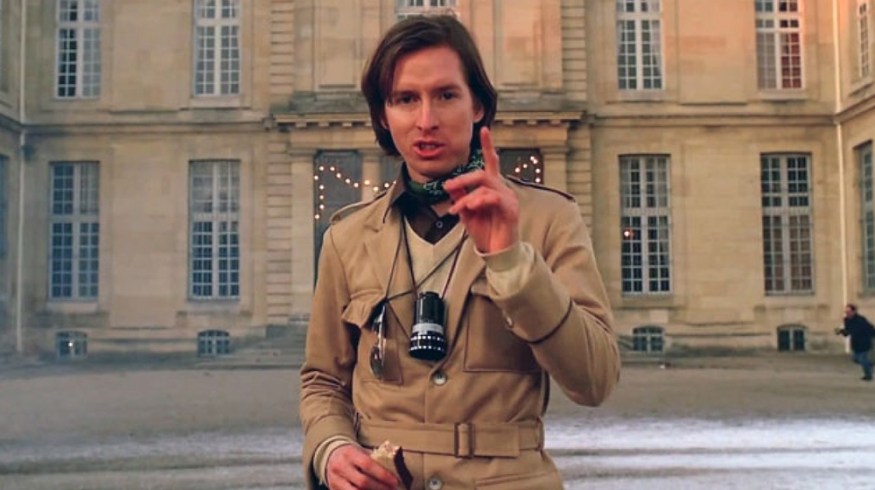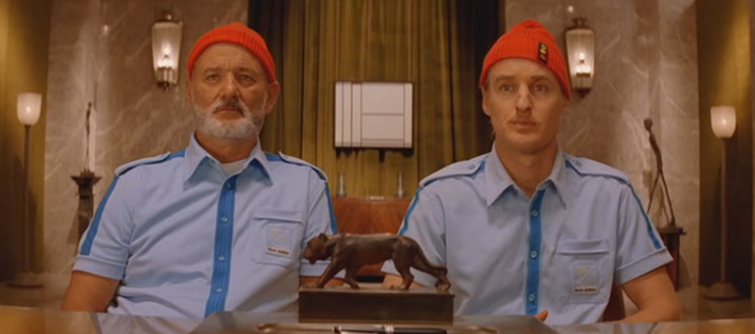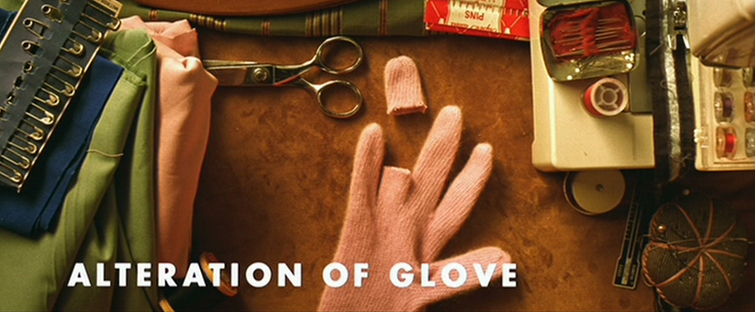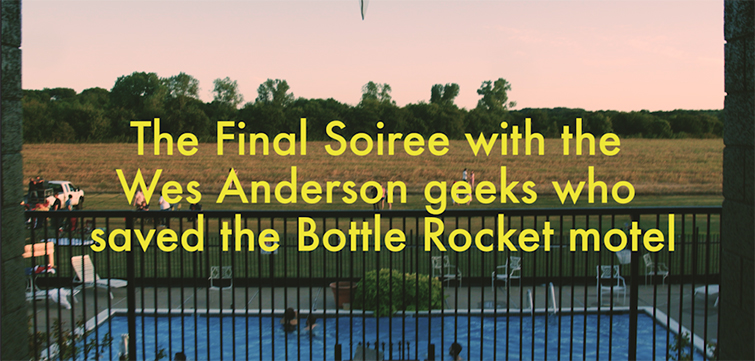
How to Stylize Your Cinematography Like Wes Anderson
Every great cinematographer has a signature style. You can develop yours by studying the experts, beginning with Wes Anderson.
Cover image from Wes Anderson‘s American Express commercial.
From Bottle Rocket to Isle of Dogs, Wes Anderson has consistently delighted cinephiles with his whimsical sense of humor and signature visual style. Whether you’re a fan or not, you’ve seen it both analyzed and parodied. However, it’s more than just tableaux and dead dogs. Anderson’s recognizable mise-en-scène is a combination of homaged compositions and coming-of-age motifs that requires a strong understanding of cinematography, color, and style.
Let’s look at several ways to experiment with footage to see how Wes Anderson established his signature style.
Flat Compositions

Image from The Life Aquatic with Steve Zissou via Touchstone Pictures.
One aspect of Wes Anderson’s cinematography (which is heavily tied to his go-to director of photography, Robert Yeoman) is the stark flatness of his compositions. As much as he possibly can, Wes creates his worlds by lining everything up directly in front of him. That is to say, he doesn’t use awkward angles. The camera can move, but if it does, it creates a new flat composition.
- The Basic Rules of Composition
- Observations on Film Art: Shot-consciousness
- 9 Composition Techniques That Will Make Your Images Eye-Catching on a Biological Level
- Video Tutorial: Composition, Framing and the 180° Rule
Create Lines

Image via The Grand Budapest Hotel (Fox Searchlight).
Wes Anderson then uses his flat compositions to create lines (which in turn creates symmetry — more on that below). For his style, it’s important to shoot with long lenses to make the lines as straight as possible. As a result, there are not many fish-eye angles in his films. For his most famous shots in films like The Royal Tenenbaums and The Grand Budapest Hotel, for example, Anderson shot on 40mm anamorphic as much as possible (Wolfcrow). Once these lines are steady, you can start placing them strategically in your composition.
- Static and Dynamic Compositions
- Cinematography Tips: Mastering Foreground, Middleground, and Background
- How to Craft a Cinematic Frame Within a Frame
- The Most Common Framing Mistakes in Cinematography
Find Symmetry
In this aspect, Wes Anderson is by no stretch the first director to make heavy use of symmetry in his films. His style, though, seems to be so popular that he seems to get the lion’s share of credit for it these days. (Stanley Kubrick would beg to differ.)
To get good symmetry, you need to be aware of three things. One, mentioned above, is to avoid angles where the lines aren’t parallel. The second is to shoot long and tight shots without a fisheye curve. The third is your rule of thirds. Wes likes to center his subject perfectly in the middle of his shot but uses the thirds to divide up all the information on either side. Once you find symmetry, you can create stylistic imbalance. Here’s an example wherein he loads one half with a small army of short scouts, contrasted against just two stark characters on the other side, creating a contradiction.
- The Art of Perspective and Symmetry in Cinematography
- The Perfect Symmetry of Wes Anderson’s Movies
- From Kubrick to Anderson: One-Point Perspective
- The geometric perfection of Wes Anderson films
Bright Color Palettes
After he has composed his shots, Wes Anderson’s signature style really begins to flourish. In the commentary of Bottle Rocket, there are anecdotes about how Wes would spend hours poring over magazine spreads during pre-production to search for the perfect color palette for his film. From Bottle Rocket on, colors have become one of his hallmark features as he uses his signature dusty pastels to create timeless image qualities.

Image of one of the Reservoir Geeks on location at the Bottle Rocket motel (Dallas Observer).
You can work some on your own, but here’s an example of a free LUT created by SmallHD called “Moonrise” dropped onto a shot. LUTs are a great option and you can download several more for other film styles (and create your own) here.
- Wes Anderson’s Color Palettes
- Wes Anderson Color Palettes (Tumblr)
- How to Color Grade Like — Moonrise Kingdom (Wes Anderson)
- Manipulating the Audience’s Emotions With Color
Dramatic Use of Slow Motion
Aside from composition and colors, perhaps the most noteworthy technique of Wes Anderson’s filmmaking style is his deft use of slow motion. Wes Anderson doesn’t use this technique as often as, say, a Michael Bay film, but he does find a way to work it in to every one of his films — usually at the very end. He also plays back some shots beginning at normal speed (in the case of film, 24fps) and then shifting into slow motion, which is actually quite an intricate technique when shooting on film.
If you’re shooting digital, you can always film a shot or scene at a higher FPS rate (frames per second) like 60fps or 12o+, then in post speed ramp the footage to a slow motion speed of your choice. When shooting on film, as Wes Anderson does, you have to use a process called “over cranking,” which you can read more about here.
- How Does Slow-Motion Video Work & How Can I Shoot It?
- Tips For Shooting the Best Slow-Motion Video
- 5 Common Mistakes to Avoid When Shooting Slow Motion
- How to Use Slow-Motion to Create Iconic Moments
Overhead Tableaux

Image from The Royal Tenenbaums via Touchstone Pictures.
I’d argue that, in some small way, Wes Anderson is at least partly responsible for Instagram’s success. An influx of Wes Anderson-inspired overhead tableau shots have seemingly taken over the app. From a style perspective, laying out inanimate objects on a table is quite simple; the real challenge is in the spacing, lighting, and selection. For many of Wes Anderson’s overhead tableaux, even the table itself is an indication of time, place, and character. The set design is articulated to match the scene, and the spacing reveals a pristine attention to detail (a trait many of his characters share).
- From Above: The Overhead Shots of Wes Anderson
- How Wes Anderson’s Cinematographer Shot These 9 Great Scenes
- Here’s What It Would Look Like If Wes Anderson Made Food Videos
- Wes Anderson Filmmaking 101: Learn the Subtle Ways the Director Pulls You into His Films
Stop Motion Animation
Another, not-so-easily replicable style of Wes Anderson’s is a penchant for stop motion animation. Yes, there are a few full-blown examples like Fantastic Mr. Fox and the most recent Isle of Dogs, but even some of his early films (most notably The Life Aquatic) make creative use of stop motion animation when showing wildlife and animals. As you can see in the video above, the process can be very long and painstaking, and it requires quite a bit of planning, creativity, and patience.
- How to Make a Professional Stop Motion Animation Video (Tutorial)
- FANTASTIC MR. FOX — In the puppet shop with Wes & Bill
- 9 Essential Tips for DIY Stop-Motion Animation
- Make a Stop Motion Animation — for Beginners
Using the Right Fonts

Image of Wes Anderson’s favorite font Futura in use (via the Dallas Observer).
On the other end of the spectrum, perhaps the most easily replicated aspect of Wes Anderson’s style is his font selections. While he has not used one single font throughout his entire filmography, Wes Anderson certainly has a few favorites that he often returns to. They range from the simple (yet stylized) Helvetica and Futura (as seen above), to the more decorative fonts like Didot and Tilda. His keen interest in typography creates opportunities in his films for his characters to write or type letters — often in very stylized iterations.
- The Font-spressionist: Wes Anderson Ranked
- Futura, Contra and the Last Four Wes Anderson Films
- Wes Anderson: the grand design behind The Grand Budapest Hotel
- Wes Anderson Fonts in Use
For more insights into Wes Anderson’s visual styles and how to create them yourself, check out some of the links below.
- A Beginner’s Guide to Wes Anderson Movies
- How to Direct Like Wes Anderson — Style and Trope Breakdown
- The 7 Best Commercials Made By Famous Directors
- Behind the Scenes With Wes Anderson
- ‘Bottle Rocket’ to ‘Budapest’: The Evolution of Wes Anderson’s Style
- 15 Absolutely Necessary Ingredients For Making A Wes Anderson Film






